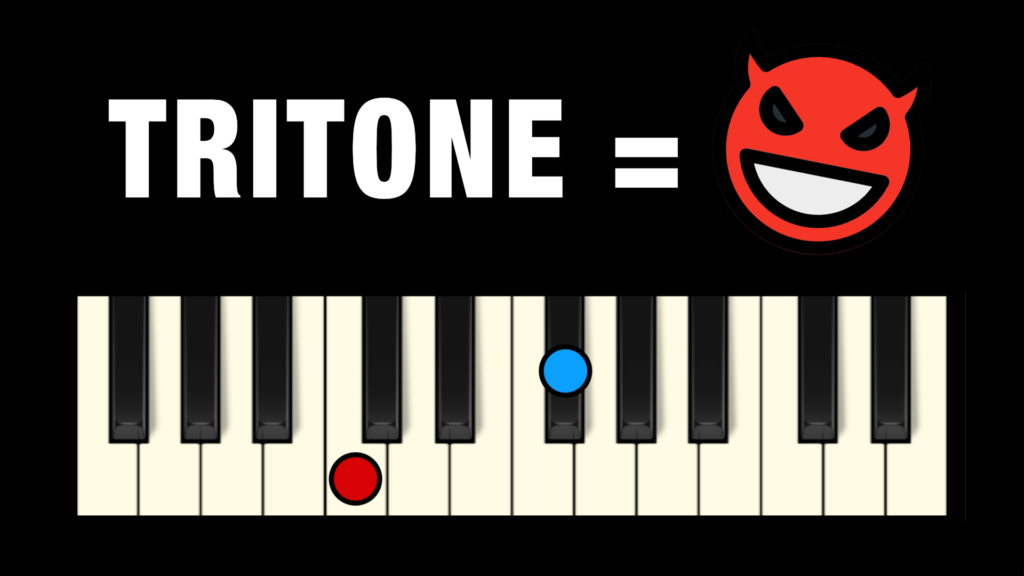Imagine a sound that sends shivers down your spine, a musical dissonance that evokes feelings of unease and darkness. This is the power of the tritone, an interval that has captivated and challenged musicians for centuries. Often referred to as the “devil’s interval” or “diabolus in musica,” the tritone has a unique and controversial history, interwoven with the evolution of music itself.

Historical Background: The Devil’s Discord
The origins of the tritone’s ominous reputation can be traced back to the Medieval and Renaissance periods. During this time, the Church exerted a powerful influence on music, dictating the acceptable harmonic structures. Musica perfecta, or “perfect music,” was based on specific ratios and intervals deemed pleasing to the ear. The tritone, however, with its jarring sound, defied these established norms. It was seen as a disruptive force, a sonic blemish that challenged the harmonious order.
There’s a story, likely apocryphal, of a 9th-century monk named Guido d’Arezzo who accidentally stumbled upon the tritone while experimenting with a new system of musical notation. The resulting sound was said to be so unsettling that he denounced it as “diabolus in musica,” forever branding the tritone with its devilish connotation.
Unveiling the Musical Mystery: Demystifying the Tritone
The tritone is a specific musical interval spanning three whole tones or six half-steps. For example, in the key of C major, the notes B and F create a tritone. The dissonance arises from the tension created by the interval’s imperfect consonance. Unlike intervals like the perfect fifth (C and G) or the perfect octave (C and C), which vibrate at simple whole number ratios, the tritone’s frequencies clash slightly, resulting in a rough and unresolved sound.

This dissonance is what gives the tritone its power. It can create a sense of unease, suspense, or drama. It can also be used to add a touch of exoticism or mystery to a piece of music.
Cultural and Symbolic Significance: The Devil Went Down to Georgia (and Beyond)
The tritone’s unsettling nature extends beyond the realm of music theory. Throughout history, different cultures have ascribed symbolic meaning to this interval. In some medieval grimoires, the tritone was associated with dark magic and the occult. It was believed to summon demons or evoke feelings of fear and dread.
This association likely stemmed from the Church’s demonization of the tritone. The interval’s dissonance served as a sonic metaphor for the forces of evil, a disruption of the divine order. Even in non-religious contexts, the tritone’s dissonant qualities have been linked to ideas of chaos, danger, or the otherworldly.
The Tritone’s Triumph: From Forbidden Fruit to Creative Tool
Despite its initial resistance, the tritone eventually found its way into mainstream music. As composers like Claudio Monteverdi and Heinrich Isaac began to experiment with chromaticism (the use of half-steps), the tritone started to appear more frequently. By the Baroque period, composers like Johann Sebastian Bach were using the tritone to create moments of dramatic tension and emotional upheaval.
The Classical and Romantic periods saw a further embrace of the tritone. Composers like Beethoven and Liszt wykorzystywali (Polish for “utilized”) the tritone to create a sense of unrest, conflict, or foreshadowing. In Beethoven’s “Piano Sonata No. 2 in A-flat major,” the tritone appears in the opening movement, hinting at the turbulent emotions to come.
The Devil’s Interval in the Details: The Tritone in Modern Music
The 20th century witnessed a complete transformation in the perception of the tritone. With the rise of jazz and blues, dissonance became an essential element of musical expression. The tritone became a building block for many jazz chords, adding a sophisticated and bluesy touch to the music. Jazz legends like Miles Davis and John Coltrane frequently employed the tritone to create a sense of improvisation and exploration.
The tritone’s influence extends to rock and popular music as well. The opening riff of Black Sabbath’s “Black Sabbath” is a prime example, featuring a descending tritone that sets the stage for the song’s dark and ominous mood. Similarly, the iconic opening notes of Leonard Bernstein’s “West Side Story” (“Maria”) utilize a tritone to create a sense of longing and yearning. Even the theme song of “The Simpsons” employs a playful tritone, adding a touch of mischievousness to the cartoon’s intro.
The tritone’s versatility is further demonstrated in its use in film scores. From the menacing undertones in horror movies to the thrilling tension in action sequences, the tritone has become a go-to tool for composers to create specific emotions in listeners.
The Science of Sound: Why the Tritone Ticks
The unsettling nature of the tritone has a scientific basis. Studies suggest that our brains perceive dissonance as a form of auditory friction. The clashing frequencies of the tritone create a temporary state of tension in the auditory cortex, similar to the feeling we might experience when encountering something unexpected or jarring. This tension is what gives the tritone its emotional power, allowing composers to evoke a range of feelings in listeners.

Beyond the Dissonance: The Allure of the Tritone
While dissonance is a key characteristic of the tritone, it’s not the only story. In the hands of a skilled musician, the tritone can also be used to create moments of surprising beauty and resolution. When a tritone resolves to a more consonant interval, the release of tension can be incredibly satisfying. This play between dissonance and consonance is what makes the tritone such a powerful and versatile musical tool.
Conclusion: A Legacy of Intrigue
The tritone’s journey from forbidden fruit to cherished musical device is a testament to the ever-evolving nature of music. Once demonized for its dissonant qualities, the tritone has become an indispensable tool for composers across genres. From the dramatic intensity of classical music to the raw energy of rock, the tritone continues to captivate and challenge listeners. Its ability to evoke a wide range of emotions ensures its enduring place in the musical landscape.
Further Reading and Listening
- Reading: “The History of Tonality” by Richard Taruskin, “Music Theory for Dummies” by Michael Pilhofer
- Why the Tritone = The DEVIL in Music – Professional Composers
- The Devil’s Interval: Tritone
- Listening:
- Classical: J.S. Bach – “Chromatic Fantasia and Fugue,” Ludwig van Beethoven – “Piano Sonata No. 2 in A-flat major”
- Jazz: Miles Davis – “Kind of Blue,” John Coltrane – “Giant Steps”
- Rock: Black Sabbath – “Black Sabbath,” Led Zeppelin – “Black Dog”
- Modern: Leonard Bernstein – “West Side Story,” Hans Zimmer – “The Dark Knight” soundtrack
Read Also
The Devil’s Betrothed by Mynovel20 eBook Summary
Where Do Deleted Files Really Go?
Storm: Dawn of a Goddess eBook Summary
FAQs
1. Is the tritone always bad?
No! The tritone can be used to create a variety of emotions, from tension and unease to beauty and resolution. It all depends on how the composer uses it within the context of the piece.
2. Can I find tritones in popular music?
Absolutely! The tritone is a common element in many rock, pop, and even film scores. Listen closely for those dissonant intervals that add a touch of drama or intrigue.
3. How can I learn more about music theory?
There are many resources available online and in libraries to help you delve deeper into music theory. Websites like Musictheory.net and books like “Music Theory for Dummies” offer a great starting point.
4. Why is the tritone called the devil’s interval?
The term originated during the Medieval and Renaissance periods when the Church exerted significant control over music. The tritone’s dissonance clashed with the established harmonic structures, leading it to be associated with the devil and evil forces.
5. How does the tritone affect me emotionally?
The tritone’s dissonance can create a sense of tension, unease, or even fear. However, it can also be used to create excitement, drama, or a sense of anticipation. Ultimately, the emotional impact depends on the context in which the tritone is used.


